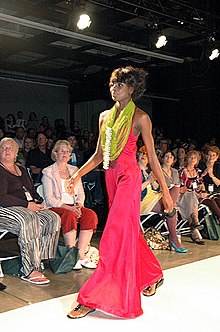
Palazzo pants (British English : palazzo trousers, Indian English: pantada) are long unisex pants cut with a loose, extremely wide leg that flares out from the waist.
Palazzo pants are popular as a summer season style, as they are loose and tend to be flattering in light, flowing fabrics that are breathable in hot weather. Silk crepe/crape, jersey, [1] and other natural fibre textiles are popular fabrics for this design. Palazzo pants are less frequently seen during the winter months, but they may be found in wool or heavy synthetic fabrics as well.